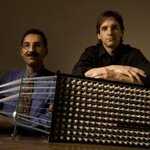Applied Physics

Just a little mechanical strain can cause a large drop in the maximum current carried by high-temperature superconductors, according to novel measurements carried out by the National Institute of Standards and Technology (NIST). The effect, which is reversible, adds a new dimension to designing superconducting systems—particularly for electric power applications—and it also provides a new tool that will help scientists probe the fundamental mechanism behind why these materials carry current with no resistance.
Magneto-optical image of magnetic fields within a YBCO superconductor showing…

Natural Sciences and Engineering Research Council grantee Peter Austin and three other researchers at the Institute for Clinical Evaluative Sciences in Toronto have just completed a survey of hospital visits in Ontario, showing that, compared to people born under other astrological signs, Virgos have an increased risk of vomiting during pregnancy, Pisces have an increased risk of heart failure, and Libras have an increased risk of fracturing their pelvises.
In fact, each of the 12 astrological signs had at least two medical disorders associated with them, thus placing people born under a…

A newly designed porous membrane, so thin it's invisible edge-on, may revolutionize the way doctors and scientists manipulate objects as small as a molecule.
The 50-atom thick filter can withstand surprisingly high pressures and may be a key to better separation of blood proteins for dialysis patients, speeding ion exchange in fuel cells, creating a new environment for growing neurological stem cells, and purifying air and water in hospitals and clean-rooms at the nanoscopic level.
Membrane sorts molecules by size. Credit: University of Rochester.
At more than 4,000 times thinner than a…

In the digital age, organizing a photo collection has gone from bad to worse. The saying used to be that a picture is worth a thousand words. Now the question arises: what are a thousand pictures worth?
"Anyone who has a digital camera has the problem that they have more photos than they can possibly navigate," says Steve Seitz, associate professor of computer science & engineering. "And it's always a problem to find the photo that you're looking for."
Photo Tourism places each photo where the photographer would have been standing. Here, one photo of Trevi Fountain in Rome is enlarged…

Computing that would normally take five million years to complete now takes five minutes, thanks to research at the University of Toronto.
A paper in the February edition of Science describes how U of T researchers created a new way of computing called "affinity propagation," which can be used to organize information in areas such as medical imaging, drug discovery, genetics, telecommunications, automobile traffic planning, school access planning and astrophysics.
Image: Brendan Frey
"Affinity propagation works by considering all possible interpretations of the data at once," says Professor…

Advances in digital electronic circuits have prompted the boost in functions and ever- smaller size of such popular consumer goods as digital cameras, MP3 players and digital televisions. But the same cannot be said of the older analog circuits in the same devices, which process natural sights and sounds in the real world. Because analog circuits haven't enjoyed a similar rate of progress, they are draining power and causing other bottlenecks in improved consumer electronic devices.
Now MIT engineers have devised new analog circuits they hope will change that. Their work was discussed at…

When the next big earthquake hits a region like San Francisco, Natural Sciences and Engineering Research Council (NSERC) grantee Kristy Tiampo wants to ensure that communities will not only be able to evacuate, but also rebuild.
This is why Tiampo, the NSERC and Benfield/ICLR Industrial Research Chair in Earthquake Hazard Assessment, is involved in an international effort to improve earthquake forecasting. She studied earthquake engineering in California as an undergraduate, and is now using her research to build better forecasting maps in Canada and other countries.
Within the next five…

Imagine a car that accelerates from zero to 60 in 250 feet, and then rockets to 120 miles per hour in just one more inch.
That's essentially what a collaboration of more than a dozen accelerator physicists has accomplished, using electrons for their racecars and plasma for the afterburners. Because electrons already travel at near light's speed in an accelerator, the physicists actually doubled the energy of the electrons, not their speed.
The blue streak in this photograph shows the dramatic gain in energy made by some of the electrons in a bunch after passing through plasma (ionized gas…

Using a unique weaving machine of their design, Duke University Medical Center researchers have created a three-dimensional fabric "scaffold" that could greatly improve the ability of physicians to repair damaged joints with the patient's own stem cells.
"If further experiments are successful, the scaffold could be used in clinical trials within three or four years," said Franklin Moutos, a graduate student in the Orthopedic Bioengineering Laboratory who designed and built the weaving machine. "The first joints to be treated this way would likely be hips and shoulders, though the approach…

Insects and other flying animals are somehow able to maintain appropriate flying heights and execute controlled takeoffs and landings despite lacking the advantage of sophisticated instrumentation available to human aviators. By characterizing the behavior of a specially designed flying robot, researchers have now been able to test a theory that helps explain how visual cues are used by insects during flight to ensure appropriate distance from the ground. The work, reported by Nicolas Franceschini and colleagues at France's CNRS and the University of the Mediterranean in Marseille, will…